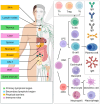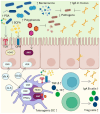Dietary Modulation of the Immune System
- PMID: 39770983
- PMCID: PMC11676904
- DOI: 10.3390/nu16244363
Dietary Modulation of the Immune System
Abstract
Recent insights into the influence of nutrition on immune system components have driven the development of dietary strategies targeting the prevention and management of major metabolic-inflammatory diseases. This review summarizes the bidirectional relationship between nutrition and immunocompetence, beginning with an overview of immune system components and their functions. It examines the effects of nutritional status, dietary patterns, and food bioactives on systemic inflammation, immune cell populations, and lymphoid tissues, as well as their associations with infectious and chronic disease pathogenesis. The mechanisms by which key nutrients influence immune constituents are delineated, focusing on vitamins A, D, E, C, and B, as well as minerals including zinc, iron, and selenium. Also highlighted are the immunomodulatory effects of polyunsaturated fatty acids as well as bioactive phenolic compounds and probiotics, given their expanding relevance. Each section addresses the implications of nutritional and nutraceutical interventions involving these nutrients within the broader context of major infectious, metabolic, and inflammatory diseases. This review further underscores that, while targeted nutrient supplementation can effectively restore immune function to optimal levels, caution is necessary in certain cases, as it may increase morbidity in specific diseases. In other instances, dietary counseling should be integrated to ensure that therapeutic goals are achieved safely and effectively.
Keywords: chronic diseases; immunity; infection; inflammation; nutrients.
Conflict of interest statement
The authors declare no conflicts of interest.
Figures




Similar articles
-
Nutrition and immune system: from the Mediterranean diet to dietary supplementary through the microbiota.Crit Rev Food Sci Nutr. 2021;61(18):3066-3090. doi: 10.1080/10408398.2020.1792826. Epub 2020 Jul 21. Crit Rev Food Sci Nutr. 2021. PMID: 32691606 Review.
-
Regulation of immune function in healthy adults: one-stop guide on the role of dietary fatty acids, gut microbiota-derived short chain fatty acids, and select micronutrients in combination with physical activity.Appl Physiol Nutr Metab. 2023 Aug 1;48(8):554-568. doi: 10.1139/apnm-2022-0456. Epub 2023 May 12. Appl Physiol Nutr Metab. 2023. PMID: 37172326 Review.
-
Bioactives in Oral Nutritional Supplementation: A Pediatric Point of View.Nutrients. 2024 Jun 28;16(13):2067. doi: 10.3390/nu16132067. Nutrients. 2024. PMID: 38999815 Free PMC article.
-
Nutrient reference value: non-communicable disease endpoints--a conference report.Eur J Nutr. 2016 Mar;55 Suppl 1:S1-10. doi: 10.1007/s00394-016-1195-z. Eur J Nutr. 2016. PMID: 26983608 Free PMC article.
-
Effects of nutrients (in food) on the structure and function of the nervous system: update on dietary requirements for brain. Part 1: micronutrients.J Nutr Health Aging. 2006 Sep-Oct;10(5):377-85. J Nutr Health Aging. 2006. PMID: 17066209 Review.
Cited by
-
Association between the geriatric nutritional risk index and adverse post-extubation outcomes for critically ill older adults: a retrospective study.BMC Pulm Med. 2025 Apr 3;25(1):151. doi: 10.1186/s12890-025-03600-5. BMC Pulm Med. 2025. PMID: 40181325 Free PMC article.
-
Gender-, Age-, and Region-Specific Associations Between Obesity and Nutrition/Health Knowledge, Dietary Diversity, and Physical Activity in Chinese School-Age Students: A Cross-Sectional Study.Nutrients. 2025 Jul 3;17(13):2214. doi: 10.3390/nu17132214. Nutrients. 2025. PMID: 40647318 Free PMC article.
-
Immunomodulatory Effects of Polysaccharides from Porphyra haitanensis in Hydrocortisone-Induced Immunocompromised Mice.Foods. 2025 Mar 17;14(6):1018. doi: 10.3390/foods14061018. Foods. 2025. PMID: 40232081 Free PMC article.
-
Nutritional Deficiencies and Management in Tuberculosis: Pharmacotherapeutic and Clinical Implications.Nutrients. 2025 May 30;17(11):1878. doi: 10.3390/nu17111878. Nutrients. 2025. PMID: 40507146 Free PMC article. Review.
-
Not All Platelets Are Created Equal: A Review on Platelet Aging and Functional Quality in Regenerative Medicine.Cells. 2025 Aug 6;14(15):1206. doi: 10.3390/cells14151206. Cells. 2025. PMID: 40801638 Free PMC article. Review.
References
-
- Sirisinha S., Darip M.D., Moongkarndi P., Ongsakul M., Lamb A.J. Impaired local immune response in vitamin A-deficient rats. [(accessed on 16 July 2023)];Clin. Exp. Immunol. 1980 40:127. Available online: https://pmc.ncbi.nlm.nih.gov/articles/PMC1536953/ - PMC - PubMed
Publication types
MeSH terms
Substances
LinkOut - more resources
Full Text Sources
Medical

